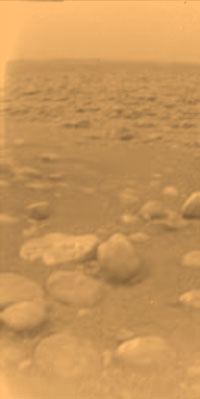
The Astrophysics Spectator
The Huygens probe successfully landed on the surface of Titan, transmitting scientific data back to the Cassini spacecraft until it dropped below Titan's horizon. This is the first probe to land on the surface of Titan, which is Saturn's largest moon. With its six scientific instruments, the probe acquired data about Titan's atmosphere and surface.

A colored image of Titan's surface after landing. The rocks visible in this image are around 10 cm in size. (Courtesy ESA/NASA/JPL/University of Arizona).
Titan is the only moon in the solar system with a dense atmosphere. At its surface, Titan's atmosphere of nitrogen and methane has a pressure that is 1.6 times that of Earth's at sea level. A methane haze pervades the upper levels of the atmosphere. The surface temperature of Titan is -179 C, so all water at the surface is frozen. However, at this temperature ethane and methane can be liquid, and it is hypothesized that Titan has shallow seas of ethane and methane.
The Huygens probe was released from Cassini on December 25, 2004, and entered Titan's atmosphere on January 14. The probe drifted on a parachute through Titans dense atmosphere of nitrogen and methane. The probe was shrouded by Titan's methane haze until it dropped below an altitude of 30 km.
The probe imaged the surface with a high-resolution camera, obtaining images of channels meandering across the surface of the moon. One series of photographs that cover 360Copyright � shows a light-colored highland rising out of a dark plain. Across the plain run streaks of white, which are thought to be a methane and ethane fog.
The spacecraft hit the surface with what the researchers described as a splat, suggesting that the surface of Titan at the point of impact is soft like mud. The surface and atmosphere as shown by Huygens has a yellowish orange color. The surface is strewn with round 10cm rocks embedded in the surface. This surface it thought to be a mixture of water ice and hydrocarbons. The surface resembles the bed of a dry river, with indications that fluid at times has flowed over the rocks.

A 360Copyright � panorama of Titan's surface as seen by the Huygens probe at 8 km altitude as it drifts to the right at 6 to 7 meters per second. The probe's landing spot is the dark region to the right in the image. The white wisps on the plain are thought to be an ethane and methane fog (Courtesy ESA/NASA/JPL/University of Arizona).
